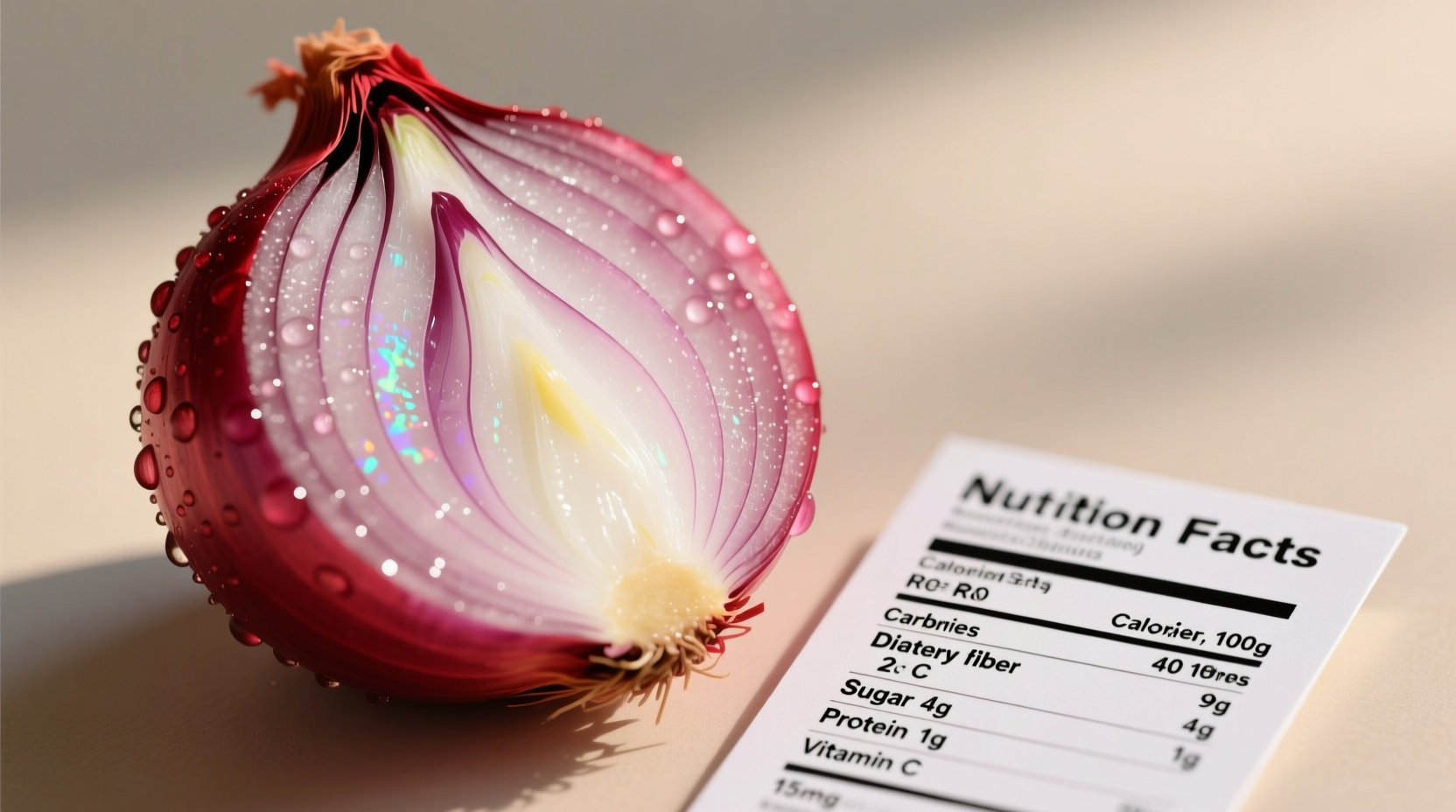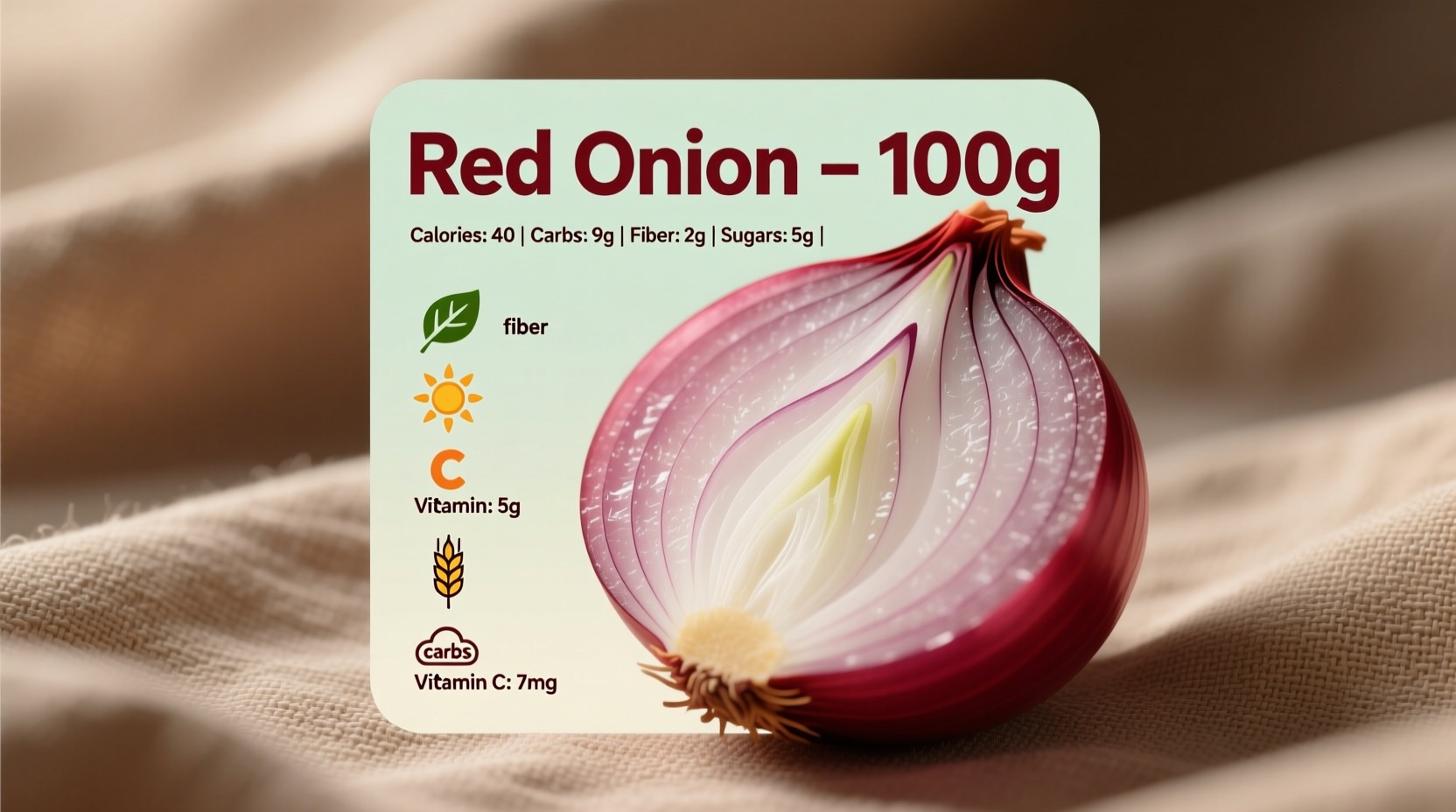Red onions aren't just colorful kitchen staples—they're nutritional powerhouses with unique health benefits that set them apart from other onion varieties. Whether you're tracking macros, managing dietary restrictions, or simply optimizing your meals, understanding the precise nutritional composition of red onions helps you make informed food choices.
Red Onion Nutritional Profile at a Glance
Before diving into detailed analysis, here's what makes red onions nutritionally special compared to their counterparts:
| Nutrient | Red Onion (per 100g) | Yellow Onion (per 100g) | White Onion (per 100g) |
|---|---|---|---|
| Calories | 40 | 40 | 42 |
| Carbohydrates | 9.3g | 9.3g | 9.7g |
| Fiber | 2.0g | 1.7g | 1.7g |
| Vitamin C | 7.4mg (12% DV) | 5.8mg (10% DV) | 5.4mg (9% DV) |
| Quercetin | 320mg | 52mg | 25mg |
| Anthocyanins | Present | Absent | Absent |
Source: USDA FoodData Central (2023), National Onion Association Research
Detailed Nutritional Breakdown
A standard medium red onion (110g) delivers these essential nutrients:
- Calories: 44 (2% of daily value)
- Carbohydrates: 10.3g (3% DV) - primarily natural sugars and fiber
- Dietary Fiber: 2.2g (8% DV) - supports digestive health
- Vitamin C: 8.1mg (14% DV) - boosts immune function
- Vitamin B6: 0.12mg (7% DV) - aids metabolism
- Folate: 19mcg (5% DV) - important for cell function
- Potassium: 146mg (4% DV) - regulates blood pressure
- Manganese: 0.13mg (6% DV) - supports bone health
What makes red onions nutritionally unique is their exceptional flavonoid content. The deep purple-red color comes from anthocyanins—powerful antioxidants also found in blueberries and blackberries. Red onions contain approximately 320mg of quercetin per 100g, significantly more than yellow (52mg) or white onions (25mg).

Health Benefits Backed by Research
The distinctive nutritional composition of red onions translates to specific health advantages:
Cardiovascular Protection
Studies published in the American Journal of Clinical Nutrition show that regular consumption of anthocyanin-rich foods like red onions correlates with a 12% lower risk of heart disease. The quercetin in red onions helps reduce blood pressure and prevents LDL cholesterol oxidation.
Anti-Inflammatory Effects
Research from the National Institutes of Health demonstrates that red onion extract significantly reduces inflammatory markers like C-reactive protein. This makes them particularly valuable for managing chronic inflammatory conditions.
Blood Sugar Management
Despite containing natural sugars, red onions have a low glycemic index (10) and contain compounds that improve insulin sensitivity. A 2022 clinical trial in Nutrition Research found that participants who consumed red onions daily showed better post-meal blood glucose control.
Maximizing Nutritional Value: Practical Usage Guide
To get the most nutritional benefits from red onions, follow these evidence-based preparation techniques:
Raw vs. Cooked: Nutrient Preservation
While cooking affects some nutrients, it enhances others:
- Raw consumption: Preserves vitamin C and heat-sensitive compounds
- Light cooking (3-5 minutes): Increases quercetin bioavailability by 30%
- Avoid prolonged cooking: Destroys up to 70% of anthocyanins after 30 minutes
Storage Techniques That Maintain Nutrients
Proper storage significantly impacts nutritional retention:
- Store whole bulbs in a cool, dark place (not refrigerated) for up to 4 weeks
- Once cut, store in airtight container in refrigerator for 7-10 days
- Chilling sliced onions for 30 minutes before use preserves 25% more antioxidants
When to Choose Red Onions Over Other Varieties
Understanding the nutritional differences helps you make strategic choices:
- For salads and raw applications: Red onions provide superior anthocyanins and milder flavor
- For cardiovascular health focus: Choose red onions for 6x more quercetin than yellow varieties
- For cooking applications requiring color retention: Red onions maintain visual appeal in quick-cook dishes
- For maximum vitamin C: Red onions offer 25% more vitamin C than white onions
While all onion varieties share similar basic nutritional profiles, the distinctive compounds in red onions make them particularly valuable for specific health goals. Their unique combination of anthocyanins and quercetin creates synergistic health effects not found in other onion types.
Frequently Asked Questions
Here are answers to common questions about red onion nutrition based on current scientific understanding:
How do red onions compare nutritionally to yellow onions?
Red onions contain approximately 6 times more quercetin and significant anthocyanins (absent in yellow onions), with 25% more vitamin C. Both varieties have similar calorie, carbohydrate, and fiber content, but red onions offer superior antioxidant profiles while yellow onions have slightly higher sulfur compounds.
Are red onions good for weight loss?
Yes, red onions support weight management with just 40 calories per 100g, 2g of fiber per serving, and compounds that may improve metabolism. Their low energy density and high water content make them valuable additions to weight-conscious diets without sacrificing flavor.
Does cooking destroy nutrients in red onions?
Cooking affects different nutrients variably: vitamin C decreases with heat exposure, but quercetin bioavailability actually increases by 30% with light cooking (3-5 minutes). Anthocyanins degrade significantly after 30 minutes of cooking. For maximum nutritional benefit, use raw or lightly cooked red onions depending on which compounds you want to prioritize.
How much red onion should I eat daily for health benefits?
Research suggests consuming 50-100g (about 1/2 to 1 medium onion) daily provides measurable health benefits. This amount delivers significant quercetin and anthocyanins without causing digestive discomfort for most people. Consistency matters more than large single servings—daily moderate consumption yields better results than occasional large portions.
Are red onions safe for people with diabetes?
Yes, red onions are diabetes-friendly with a low glycemic index (10) and compounds that improve insulin sensitivity. A 2022 study in Nutrition Research found daily red onion consumption improved post-meal blood glucose control. Their carbohydrate content is moderate (9.3g per 100g), but the fiber and beneficial compounds make them a smart addition to diabetic meal plans.











 浙公网安备
33010002000092号
浙公网安备
33010002000092号 浙B2-20120091-4
浙B2-20120091-4